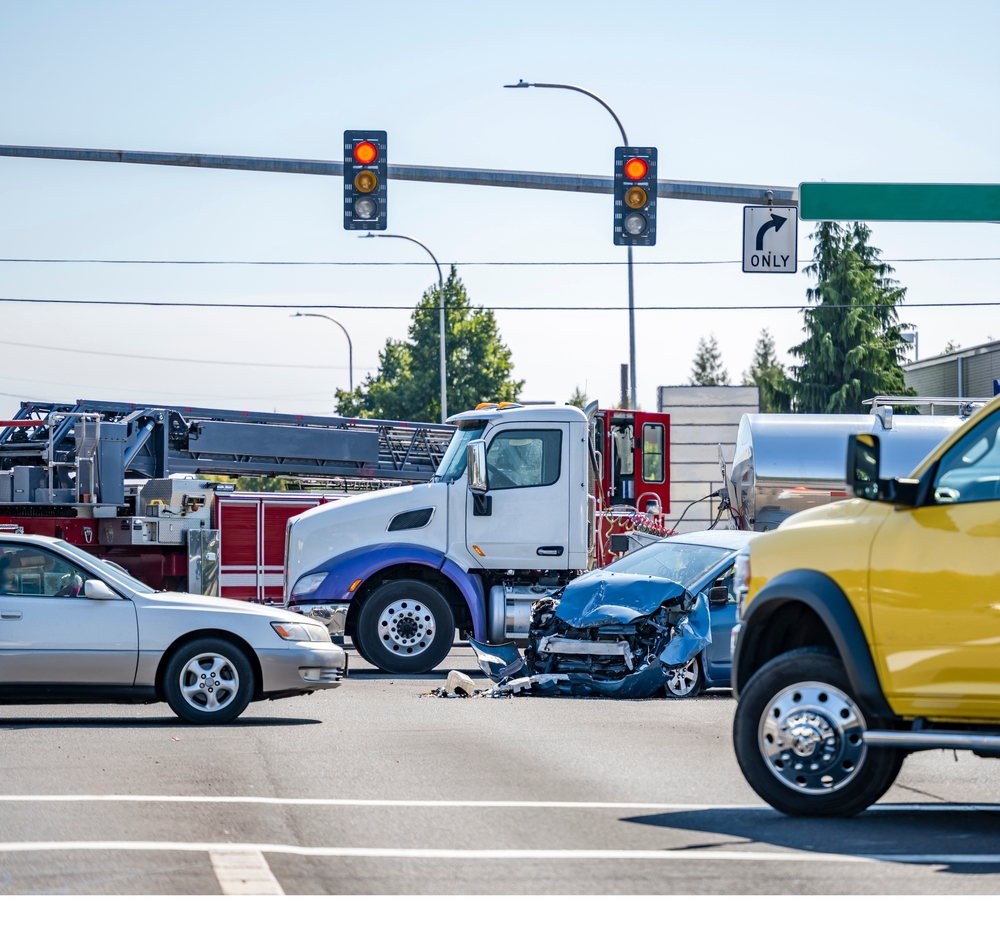There are 13.86 million semi-trucks registered in the United States, 5% of the total number of registered vehicles.[1] Each day these trucks transport goods and materials across U.S. roads to keep the economy running and deliver vital necessities to communities. In 2021, these trucks traveled a combined 327.48 billion miles and transported 72.6% of the nation’s freight by weight.[2]
Trucks are vital, but they’re also dangerous. Large trucks weigh more than 10,000 pounds and heavy trucks more than 26,000 pounds. Their sheer size, combined with a lack of maneuverability, slower stop times, and drivers often pushed to the limit, mean that trucks can cause severe injuries or death if involved in an accident.
How Common Are Trucking Accidents?
According to the National Highway Traffic Safety Administration (NHTSA), in 2021 truck accidents comprised 21% of the total number of motor vehicle accidents on U.S. roads, or roughly 523,993 truck-involved crashes. Truck accidents were responsible for 6% of all motor vehicle injuries but more than twice as many deaths, at 13.4%.
Large trucks were involved in 5,700 fatal crashes in 2021, an 18% increase from 2020 and a 24.9% increase from 2016. Fatal truck accidents caused 5,788 deaths, a 2.9% increase over the number of fatalities in 2020, but only 9% of the total annual fatalities from motor vehicle crashes.[3] Large trucks were involved in 117,000 injury-only accidents, an 11% increase from 2020, and 401,000 property-only accidents, a 25% increase from 2020. [4]
In Illinois, the percentage of truck accidents is smaller, but only on the surface. In 2021, trucks were involved in 3.8%, or 11,233, of the 295,604 motor vehicle crashes that happened on the state’s roads.[5] Yet those small numbers are deceiving. During 2021 Illinois ranked 6th overall for the number of fatalities due to truck accidents; the state ranked 7th for the number of fatal crashes.[6]
What Are the Most Common Causes of Truck Accidents?
Like crashes involving passenger vehicles, truck accidents are caused by a variety of reasons.[7]
Obstructed Lane: The size and weight of trucks make them far less maneuverable than passenger vehicles and takes them longer to stop. It takes roughly 5 to 6 seconds for a fully loaded, 80,000 pounds truck traveling at ideal conditions and a normal rate of speed to come to a complete stop – 40% longer than a passenger vehicle.[8] So, it’s not surprising that in 63% of fatal accidents involving trucks, the first incident that precipitated the crash was the presence of something – another vehicle, a motorcycle, an animal, or a pedestrian – encroaching into the truck’s lane.
Speeding: In 2021, driving more than 55 mph was a contributing factor in 41.4% of fatal truck accidents, compared to 29% of crashes involving passenger vehicles only.[9]
Driver Error: In 24% of fatal truck accidents, the precipitating event was truck driver error, such as loss of control of the vehicle or encroaching into an adjacent lane and not being able to recover.
Truck Defects: Only 4% of fatal truck accidents were caused by factors related to the vehicle itself, whether a defect, improper loading, or some other issue outside of the truck driver’s control.
Driving While Intoxicated: Only 3% of truck accidents involved an intoxicated driver, a number that has remained relatively stable over the past decade. Compare that to non-truck collisions where the driver was intoxicated: 28% of motorcycle drivers, 24% of drivers of passenger vehicle, and 20% of drivers of light trucks were intoxicated.
Are Trucks More Prone to Accidents?
Trucks aren’t more prone to accidents than passenger vehicles or motorcycles. Instead, they have a greater potential to cause serious injury due to their size. Nationally, 79% of all crashes on U.S. roads involved vehicles other than large trucks; in Illinois, 96.2% of all motor vehicle crashes involve vehicles other than a large truck.
Why Are Truck Accidents Increasing?
Although truck accidents are a small percentage of the total number of annual motor vehicle crashes, the numbers have been steadily increasing. In 2021, the number of trucks involved in injury-causing accidents increased by 11% from 2020, while fatal crash involvement increased by 17% over that same period – 23.7% since 2016.[10]
In Illinois, however, the rates decreased, with a 0.8% decrease in the number of fatalities and a 1.9% decrease in the number of fatal crashes from 2020.
There are several reasons for the overall national increase, and the number of truck accidents in general.
Number of vehicles on the road: The 13.85 million registered trucks in 2021 is the highest it’s ever been – a 7.4% increase over 2020 and a 20.5% increase since 2016. The more trucks on the road, the higher the chance they’re involved in an accident.
Fewer drivers. The trucking industry is currently down 80,000 drivers, and it is estimated it’ll be down 130,000 by 2030. Low pay, lack of benefits, and the demands of the job make attracting new drivers difficult, and its ageing workforce is retiring. The lack of drivers doesn’t, however, change the demands for trucking services – which means truck drivers are pushed to the limit to deliver their cargo on time. This increases the risk of driving errors due to drowsy driving, speeding, or carelessness.
Inexperienced drivers. Fewer drivers mean companies are forced to hire drivers with less experience, which increases the risk of driving errors.
Illinois Truck Accident Lawyers

If you or a loved one has been injured or killed in a truck accident, the truck accident attorneys at The Good Law Group can help. We have more than 35 years of experience helping clients receive the compensation they’re owed for their injuries. We offer free case consultations and work on a contingency fee basic, which means you pay nothing unless we win. To schedule an appointment call (312) 629-1212.
[1] American Trucking Associations. Economics and Industry Data. www.trucking.org/economics-and-industry-data
[2] Id.
[3] Department of Transportation Federal Motor Carrier Safety Administration (FMCSA) Analysis Division. Large Truck and Bus Crash Facts 2021. www.fmcsa.dot.gov/sites/fmcsa.dot.gov/files/2023-11/LTBCF%202021-FINAL%20508_0.pdf
[4] Id.
[5] Illinois Department of Transportation. 2021 Illinois Crash Facts & Statistics. idot.illinois.gov/content/dam/soi/en/web/idot/documents/transportation-system/resources/safety/crash-reports/crash-facts/2021-crash-facts.pdf
[6] FMCSA. Large Truck and Bus Crash Facts 2021.
[7] Id.
[8] Utah Department of Transportation. Stopping Distances. trucksmart.udot.utah.gov/stopping-distances
[9] National Highway Transportation Safety Administration. Speeding. www.nhtsa.gov/risky-driving/speeding
[10] FMCSA. Large Truck and Bus Crash Facts 2021.









